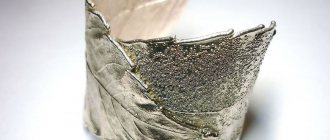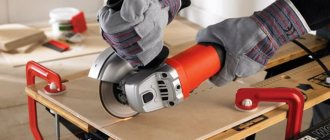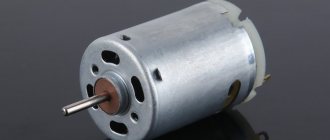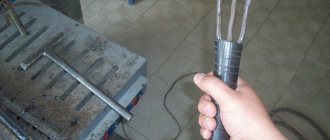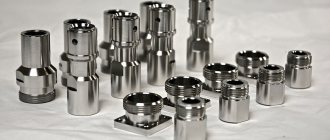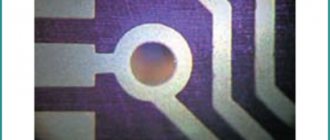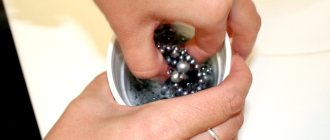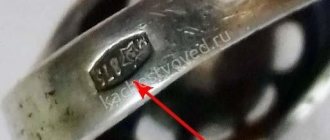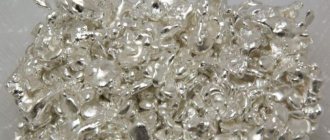What metals are plated with silver? When is metal silvering necessary?
Silver plating is required in cases where the product is to be given the properties of a precious metal of the highest standard.
Typically, objects made of copper, aluminum, steel, and brass are subjected to the silvering process. Cutlery made from cupronickel, nickel silver, and monel must be silvered, since these alloys can oxidize upon contact with food.
It is easiest to silver light-colored metals. To give dark materials the properties and color of pure precious metal, a sputtering thickness of about 15 microns will be required.
Electroplating decoration
Silvering of metal is suitable for the following items:
- Titanium. Usually BT-1 alloy is coated, other materials are difficult to process;
- Steel. It is possible to coat the material with a silver layer, but additional nickel or copper plating will probably be required;
- Bronze. The material easily “adheses” to silver molecules, which allows you to quickly apply a protective coating;
- Brass. When working with such an alloy, there is no need to apply an additional protective layer;
- Cupronickel or nickel silver. Treatment is necessary for everyday use of the material, as it allows it to become hypoallergenic;
- Copper. The material has a hardness similar to silver. The coating will improve electrical conductivity;
- Precious metals. Silver, gold, platinum are some of the most preferred elements for electroplating;
Interestingly, not only metals are coated with silver. For example, the substance silvermedin is used to form a protective coating in plants.
How to silver plate metal at home
Silvering copper and brass at home does not require special skills or rare reagents. There are many techniques for coating another metal with silver.
This is done in order to give it not only decorative properties: silver-plated metal will have other technical characteristics.
The silvering process involves the ability of certain silver compounds to decompose in the presence of metals, releasing metallic silver.
Silver plating at home
Silver coating of metals has its own characteristics:
- The most commonly plated materials are brass, copper or zinc. Aluminum and some other metals lend themselves well to silvering.
- Brass lends itself best to silvering. Copper is much darker, which affects the color of the final product: due to the thin layer of silver plating, dark metal is visible. To avoid this, the products need to be coated with a thicker layer, and this is technologically more difficult.
- At home, this procedure should be performed in a well-ventilated area. The surface is first cleaned of grease, oil and dust using alkaline solutions.
There are several methods of silvering, some of them require special equipment, others are easy to do at home. The most common method is the chemical method of applying silver.
Silvering when heated
There are several ways to coat a copper product at high temperatures.
For the first method, prepare a solution of six parts salt, one part silver chloride, and six parts cream of tartar. Add a little water to it until it becomes a paste. This solution should be stored in dark glass containers.
Copper products are placed in 5 liters of water, to which 3 tbsp is added. l. this solution and boil for 20 minutes. The silvering itself is carried out in a copper cauldron, into which objects are placed on a porcelain sieve, stirring continuously. The products are immediately covered with a silver film.
However, the method will not give a shiny coating; for this, the product must be kept for 10–15 minutes at a temperature of 70–80 degrees in a solution of four liters of water, 300 g of sodium sulfide salt and 100 g of lead acetate salt.
Brooch before and after silver plating
Silver plating using paste:
- A more dense coating is obtained by using silver nitrate, or lapis pencil. To do this, take 2 g of silver nitrate and dissolve it in 300 ml of water. Gradually, hydrochloric acid and table salt diluted with water 1:10 are added to the composition; do this until silver chloride in the form of flakes stops falling out. After this, the precipitate is filtered and washed. Next, the resulting silver chloride is added to a solution with 20 g of sodium hyposulfite and 100 ml of water. After the silver has finished dissolving, the mixture is filtered and mixed with chalk. The resulting paste is used to rub copper to obtain a silver coating.
- There is another way. Take 6 g of silver chloride and add 8 g of table salt and cream of tartar. This powder must be stirred and crushed in a mortar. The paste is prepared by dissolving in water.
- For the next method, the following ingredients are dissolved in water to obtain a paste: 2 g of cream of tartar, 4 g of ammonia and 1 g of silver nitrate.
- Silvering of copper can also be carried out with such a paste. Dissolve 10 g of silver nitrate in 50 g of water, then add a mixture of water (50 g) and potassium cyanide (25 g) to the solution. To obtain a paste, add a mixture of 10 g of cream of tartar and 100 g of chalk. After treatment with the paste, metal products are rinsed and dried.
It is recommended to store such compositions in powder form for no more than a year.
We recommend other articles
Silvering of metal
In industry, silver plating of metals is used to give them properties such as chemical resistance, excellent reflectivity, and high thermal and electrical conductivity.
The antibacterial properties of the noble metal are used. Its thin layer adds beauty to interior items and jewelry. There are several ways to silver plate metal.
Any of them requires preparation - the part is degreased, etched with acid and washed.
Silver plating using chemical methods
To apply a layer of silver, the product is rubbed with a special mixture using suede, raw leather, cork, or a brush (depending on the composition used).
The paste may include silver chloride or silver nitrate, as well as cream of tartar, table salt, potassium cyanide, washed chalk, and distilled water.
At home, a lapis pencil with the addition of salt, soda and water is often used. Once the process is complete, the item is washed and polished.
Silvering of metals can be carried out by immersion in a solution (without passing a current). The advantage of this method is the ability to create a coating on metals without a copper sublayer. The aesthetic characteristics of silver plating depend on whether the surface of the product was smooth or matte.
Silver plating can be carried out by boiling in a solution. A copper boiler and a sieve are used for this. To add shine to silver-plated products, they are processed in a different solution.
Another method of silver plating involves the use of a zinc contact. A well-cleaned object immersed in a concentrated solution is touched with a zinc stick, which is changed periodically.
Silver plating with silver leaf
The ancient method of silvering involves the use of silver leaf, the thinnest sheet of metal of the highest standard.
The sheet easily fuses with the surface of metal products and provides anti-corrosion, protective, and decorative qualities.
The silver is applied with a muzzle and then treated with a protective coating: tsapon-varnish, colorless shellac. Items take on the appearance of natural silver.
Features of silver coating of different metals
- Coating bronze with silver to a certain extent compensates for the fragility of the material. In the case of alloys containing nickel and lead, silver creates a barrier against the penetration of these harmful substances. Silvering of bronze is usually carried out on a copper sublayer;
- Plating brass with silver does not require the use of a copper sublayer. If the alloy contains nickel, then silver takes on protective functions (silvering of brass jewelry eliminates the risk of developing allergies);
- Coating copper with silver increases its chemical resistance. It is carried out taking into account the reddish tint of the metal - a thin layer of material applied when rubbing the product with paste does not create the desired decorative effect. Silvering of copper by electroplating provides the best result;
- Titanium is coated with silver to increase electrical conductivity. Due to the presence of a dense oxide film on the surface of titanium, special preparation is required - after degreasing the surface, annealing is carried out in a vacuum for an hour at 700 degrees;
- Silvering of cupronickel is performed for decorative and protective purposes. The alloy contains, in addition to copper, nickel and zinc, which can cause allergies;
- silvering of steel requires the sequential creation of sublayers of nickel and copper;
- Invar is coated with silver to increase its anti-corrosion properties (this material is susceptible to corrosion in humid air). Silvering is carried out on a copper sublayer.
Silvering is a procedure that can be performed at home, but it is not always possible to achieve high-quality plating. Only by entrusting the work to professionals can you get the perfect result.
What do you need to silver silver copper at home?
Silvering copper objects or jewelry at home is not very difficult. There are many different and fairly simple methods that do not require rare reagents. The solution for silvering is quite accessible for self-preparation.
Electroplating silvering at home is quick, easy and effective. Step-by-step instruction
Electroplating silvering at home can be done in several ways that do not require expensive chemicals.
With the galvanic method, you will need to connect the workpiece to the cathode, and the silver item to the anode. Under electrical influence, silver molecules will begin to collect in the electrolyte on the workpiece, which will become a protective coating.
Let's look at the electroplating process step by step.
Prepare the necessary tools
The process will require:
- Plastic or glass dielectric container of suitable sizes;
- Electrolyte;
- Silver;
- DC source;
- Holder for fixing;
It is also recommended to purchase jewelry scales, since you will need to measure reagents with an accuracy of up to a gram. You can purchase the necessary equipment cheaply via the Internet, at auto and building materials outlets.
Prepare solutions and chemical reagents
The composition of the solution depends on the alloy of the object being processed. Silvering of copper is possible using the following essence:
- Silver chloride - 10 grams;
- Sodium carbonate - 45 grams;
- Potassium cyanide - 45 grams;
- Sodium chloride - 20 grams;
- Aqueous solution of ammonium hydroxide - 80 ml;
There are several types of electrolytes for silvering, including:
Hydrogen electrolyte with soda
Sulfur dioxide electrolyte for silvering contains:
- Silver chloride - about 20 grams per sheet of mixture;
- Potassium hexacyanoferrate - about 20 grams per liter;
- Soda ash - about 30 grams per liter;
The electrolyte will be characterized by a reaction at low current concentration and room temperature.
Electrolyte and soda
Hydrogen electrolyte with potash
The heating of such an electrolyte can be increased to 750 °C, and the cathode concentration of electricity can be increased to 2 A/dm2.
Silver plating using heat
- Mix and dilute with water to obtain a creamy consistency:
- silver chloride 100 g;
- cream of tartar 600 g;
- table salt 600 g.
The finished composition is tightly sealed in a brown glass vessel and placed in a dark place.
To carry out silvering, a small amount of the resulting mixture is dissolved in water and brought to a boil, where the copper parts are processed for 15-20 minutes. The silvering process is carried out in a copper cauldron, into which objects are placed in a porcelain sieve. The solution is prepared at the rate of 3 tbsp. spoons of mixture per 5 liters of water.
The silver coating turns out matte and to add shine, a composition is prepared from the following ingredients:
- water 4.8 l;
- sodium sulfide salt 300 g;
- vinegar-lead salt 100 g.
When the solution is heated to 70-80 degrees, lead sulfide is released. The parts are lowered into the boiler for 10-15 minutes and upon completion the metal surface becomes shiny.
- Silver chloride, obtained from 25 g of silver nitrate, is mixed with cream of tartar (150 g), table salt and water to a liquid slurry. The finished mixture is kept in a dark container.
Silvering is done in a five-liter enamel cauldron, into which water is poured and brought to a boil. Add 2-3 tbsp to the container. spoons of a mixture that does not completely dissolve. Copper parts are treated in a boiling solution in a clay or porcelain sieve, while stirring them with a glass or wooden rod. To repeat the procedure, a new mixture is added to the boiler.
Silver plating by immersion in solution.
- To obtain a denser film of silver at home, prepare the following solution.
- ammonia 70 g;
- silver chloride 10 g;
- crystalline soda 40 g;
- potassium cyanide 40 g;
- table salt 15 g.
All these substances are mixed and distilled water is added to a volume of 1 liter. Metal parts are lowered into the container at the same time as a piece of zinc or mounted on a zinc plate.
- To prepare the solution, a composition is made from the mixture:
- silver nitrogen salt 11 g;
- potassium cyanide 60 g;
- exhausted chalk 750 g;
- water 60 g.
Take one part of the mixture and add two parts of distilled water, and immerse the metal part in the resulting paste. Large objects can be wiped with a sponge or rag soaked in the solution. Upon completion, the product is rubbed with chalk and polished with a piece of leather.
- Contact silvering method
- carbon-silver salt 10 g;
- sodium sulfide salt 100 g;
- water 100 g.
The substances are mixed and dissolved in water, stirring constantly during the process. The finished solution is drained, filtering off the precipitate. The products are lowered into a container with a solution, where they come into contact with a zinc stick.
Nuances of galvanic silvering
Do-it-yourself electroplating is a rather complicated procedure. To achieve a positive result, it is necessary to take into account the properties of the material being processed, take precautions, and carry out the process in accordance with strict sequence.
It is worth considering that independent galvanic silvering cannot seriously enhance the strength of the alloy; the result is aimed, rather, at performing a decorative function. To obtain an impressive protective layer, the procedure must be carried out about 10 times in a row.
The thickness of the coating during a one-time procedure is thinner than a human hair (about 20 millionths of a meter).
It is better to clean and degrease the surface to be treated
The product to be treated can first be degreased with alcohol or sandblasted. Sanding with special pastes or sandpaper is also suitable.
Some tips
In fact, the silvering process is not as simple as it might seem at the very beginning. The procedure has a number of features that must be taken into account when performing, they are as follows:
- Most often, copper, brass or aluminum objects and products are subjected to the silvering procedure. During processing, these alloys, interacting with the solution, create a reaction, as a result of which they begin to release metallic silver. This is what allows this technological process to take place.
- The easiest way to coat light metal surfaces with silver. If products made of dark metal are used, then it is necessary to apply a layer at least 10-15 micrometers thick, otherwise the dark surface will show through and spoil the appearance.
- During the procedure, regardless of where it is carried out - at home or in a production facility, it is necessary to ensure good ventilation.
- To achieve a higher quality silver coating, you need to thoroughly clean and degrease the surface to be treated.
- It is advisable to apply special pastes that are used for silvering metal with a soft cloth or a small piece of leather.
These are the main methods of silver plating that can be used in an apartment. It’s quite possible to make them yourself, and the ingredients used for production are sold in the public domain.
Alternative methods of silvering metals
Silvering metal at home is possible in a number of alternative ways. They will require special reagents, as well as compliance with safety measures.
Other silver processing methods include:
Chemical surface treatment
The technology involves the use of chemicals that bind to the material being processed, forming silver microparticles.
The basis of the chemical treatment is antichlorine, a special reagent used in the photography industry. You will also need:
- Formalin - about 10 drops;
- Ammonia - about 10 drops;
- Sodium thiosulfate - 1 liter;
The processing itself looks like this:
- Formaldehyde and ammonia are added to the antichlorine.
- Clean the surface of the metal product, then immerse it in a boiling soda solution. Afterwards, rinse with running water.
- The product must be immersed inside a container with antichlorine and left for 2.5 hours.
- After removing the item, it must be washed and dried.
Polishing silver plating
Immersion technology
How to silver plate metal using the immersion method? With this method, the product being processed is immersed in a silvering essence, which consists of certain substances. The composition depends on the alloy of the product.
Secrets of successful fishing: Homemade spinners - silvering the spinner
Homemade spinners.
One of
the methods for refining a spoon
is silver plating, especially matte, which makes the spoon even more catchy. This finish is applicable in all seasons and in all lighting conditions. It may turn out that after silvering you will not need to change the game of the spoon in order to increase the catchability of the spoon.
The process of silvering a spinner is not complicated.
First, the spoon is cleaned of dirt and grease, washed in a soda solution and clean water. Then the bait is dipped into some vessel with a spent photographic fixer, but not into an acidic fixer. This operation will give the lure a matte silver color. All that remains is to rinse it in clean water, wipe with a cloth and dry. This is how a silver bait appears, which large fish will grab as if it were completely made of precious metal.
Using the used fixer, you can make the lure two-color.
To do this, it is polished, and then one of the sides to be silvered is degreased and rubbed with tooth powder. The prepared spoon is dipped into the used fixer for 5-6 hours. The degreased side of the spoon becomes silver, and the other turns golden if it is reddish copper, or yellowish if it is brass.
Spoons are also silvered using other methods.
Here's one of them. The cleaned copper spoon is rubbed moderately with a lapis pencil. The silver contained in it remains on the copper surface. The effect will be stronger if this operation is repeated twice. Silvering a spinner using a lapis pencil can be done in another way. The pencil is crushed to a dusty state, mixed with 1 teaspoon of table salt and 1 teaspoon of soda. Then add water to create a creamy mixture. It is rubbed into the bait with a cotton swab or cloth, and after a layer of silver appears, the spoon is washed in water. Then the spinner is either passivated or covered with a protective coating in the form of a dull varnish.
Necessary ADVICE
In order for the “precious” coating to last longer, the bait is passivated (in other words, a film is made on the surface to protect metals from corrosion). To do this, the spoon is dipped into a warm solution of 1% chromium (potassium dichromate). If an artificial silver-plated bait needs to be given only an initial shine, it is washed with warm water and soap and a thin layer of tooth powder and ammonia is applied. When the mixture dries, all that remains is to clean the spoon with a cloth.
Silvering of a spinner can also be done using tin and mercury. The composition for silvering should consist of 65 parts by weight of tin and 35 parts by weight of mercury. Instead of tin, you can use a third or lead, but then the spinner will not be as light. Mercury can be used from the broken axis of a honey thermometer.
With all this, you should keep in mind that mercury vapor is poisonous and you must protect your breath from it. Without removing from the heat, pour mercury into the molten tin (a vessel made of aluminum, copper and other non-ferrous metals is unsuitable) and quickly stir with a wooden spatula, but not a resinous one. The resulting mass is cooled, dried, crushed and, finally, ground into powder in a porcelain or iron cup. Then it is combined with 26-27 parts by weight of talc and 5-8 parts of some crystalline, also painstakingly ground, acid, for example citric, oxalic, tartaric. The composition is applied to the surface of a copper, brass or bronze spoon and rubbed, after which the product is thoroughly washed. If there is no acid in the composition, then before rubbing the spoon, lubricate it with the juice of sour grass or berries (sorrel, cranberry, etc.). The composition is not caustic and does not decompose in light.
Section question - answer
Do-it-yourself silver plating using an anode and cathode, what is it?
Expert opinion
Andrey Seleznev
Chemist-technologist, Volgograd
Such galvanization of a house is the transfer of molecules when an electrical circuit is closed. The metal object being processed is connected to the cathode, and the silver object is connected to the anode. Silver molecules, under the influence of direct current, will begin to move to the cathode, becoming a protective layer.
Electroplating with silver, what GOST?
Expert opinion
Andrey Seleznev
Chemist-technologist, Volgograd
Even if the product is plated silver, it is based on a different alloy. For example, copper alloys in the Russian Federation are regulated by GOST 859-78.
Table: cost of professional silver plating
Specialized companies offer galvanic work at an affordable price and in the shortest possible time. Professionals help you select the thickness, prepare the surface, and carry out final processing.
Contacting specialists will help you save your health, money and personal time.
The table below shows the average prices for electroplating work for jewelry, current for 2021:
| Service | Price | Minimum order price | The service includes |
| Full Coverage | 100 rubles per gram | From 1200 rubles | Cleaning and polishing of the product |
| Partial coating with electroplating pencil | 250 rubles per 1 cm2 | From 300 rubles | Cleaning and polishing of the product |
| Restoration of the coating | 150 rubles per 1 cm2 | From 300 rubles | Cleaning and polishing of the product |
For an additional cost, you can order polishing of the jewelry, which allows you to get rid of severe nicks and scratches.
Security measures
Chemical silver plating must be carried out with proper precautions.
- For work you will need: closed-type glasses, rubber gloves, a rubberized apron, a respirator.
- The process is only possible if there is good ventilation or in the open air.
- Reagents must be stored separately from each other.
- Removing silver-plated objects from galvanic baths should only occur after removing the electrical voltage.
- Waste must be disposed of according to safety regulations.
